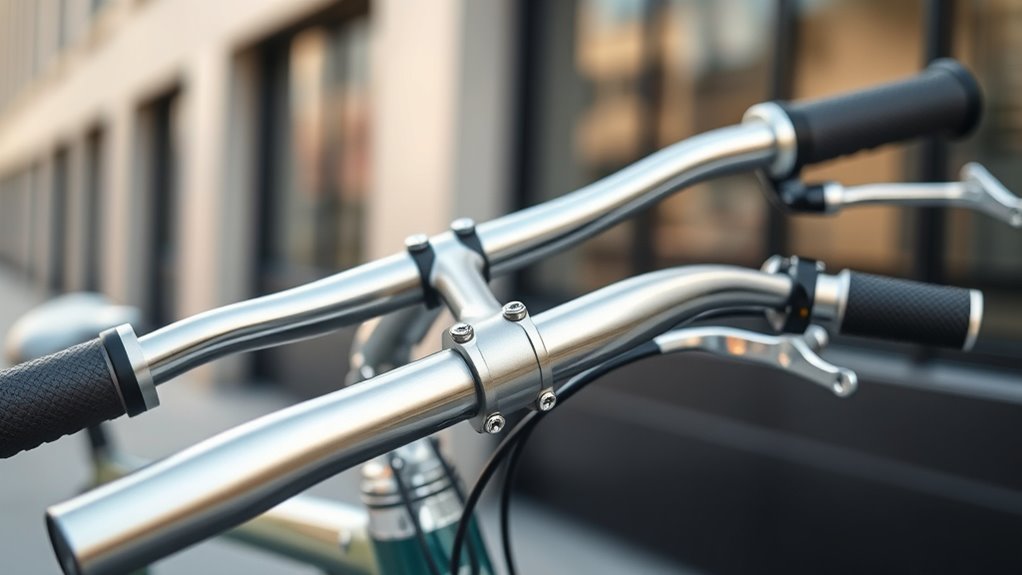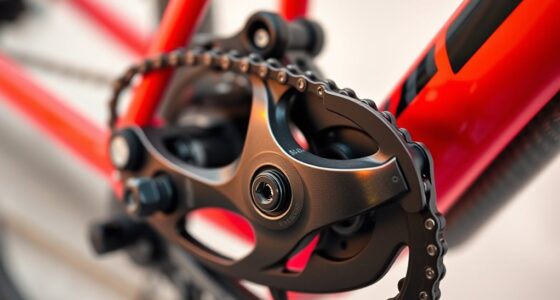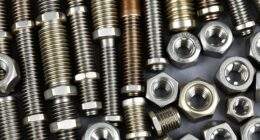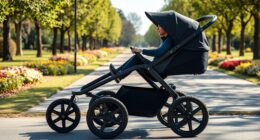Handlebar types vary greatly to suit different riding styles and comfort needs. Drop bars are great for aerodynamics and long rides, offering multiple hand positions. Flat bars are simple and practical, perfect for city commuting and casual riding. Riser bars improve control on off-road trails, while bullhorn bars deliver reach and leverage for spirited riding. Aero bars boost speed for racing. Exploring these options helps you find the best fit—if you keep exploring, you’ll discover all their unique benefits.
Key Takeaways
- Handlebar types include drop bars, flat bars, riser bars, bullhorns, and aero bars, each suited for different riding styles.
- Drop bars offer multiple hand positions and improved aerodynamics, ideal for racing and long-distance rides.
- Flat bars promote upright riding, better control, and are popular for city commuting and casual cycling.
- Riser and bullhorn bars enhance comfort and handling, especially for off-road, trail, or urban riding.
- The choice of handlebar depends on riding activity, comfort preferences, and bike compatibility.
Understanding Drop Bars and Their Benefits
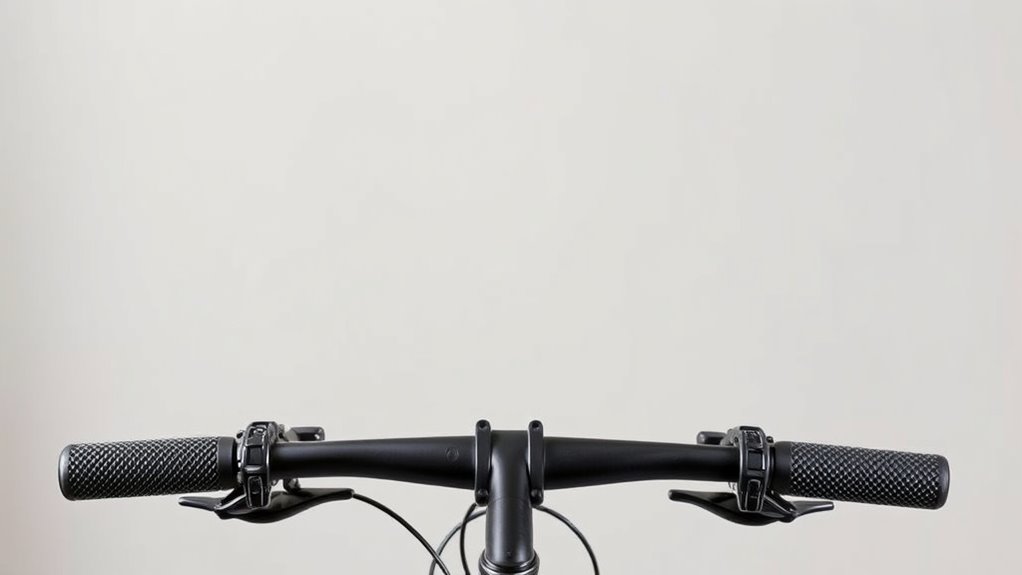
Drop bars are a popular handlebar choice among cyclists because they offer multiple riding positions and improve aerodynamics. With their ergonomic grip, you can comfortably switch between riding styles, reducing fatigue on long rides. Properly adjusting your handlebar width can enhance control and comfort during your ride. The handlebar width is essential, as a wider bar provides better control, while a narrower one enhances speed and streamlining. Drop bars allow you to adopt a more aerodynamic posture, especially when you lower your hands to the lower sections, minimizing wind resistance.
This versatility makes them suitable for road racing, long-distance riding, and casual cycling. By choosing the right handlebar width and ensuring an ergonomic grip, you optimize comfort and performance, allowing you to ride more efficiently and with less strain on your hands and wrists.
The Features and Uses of Flat Bars
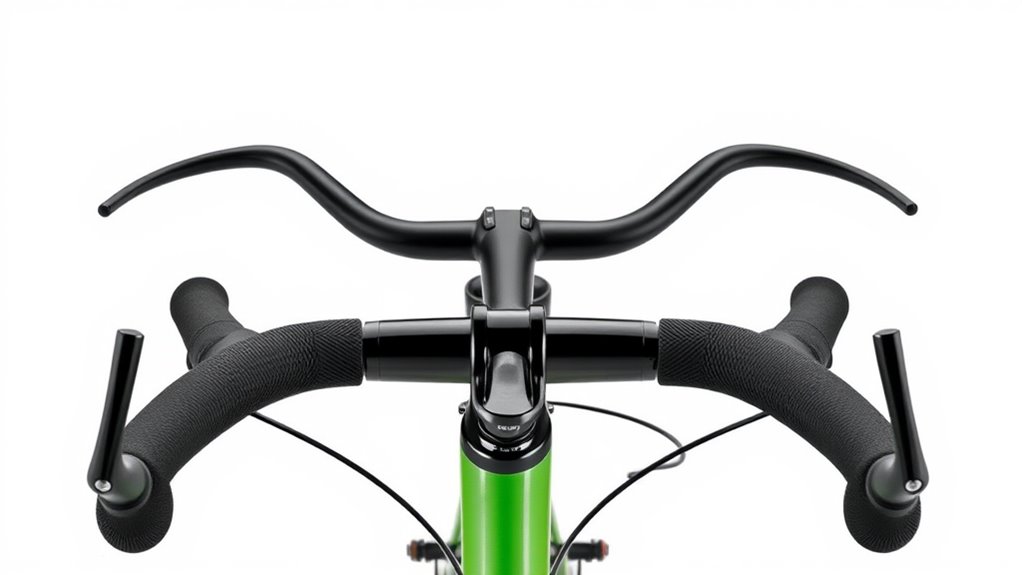
Flat bars are a popular handlebar choice for many cyclists due to their simplicity and practicality. They offer excellent handlebar ergonomics, promoting an upright riding position that reduces strain on your back and shoulders. This makes flat bars ideal for city commuting, leisurely rides, and short-distance cycling.
You can easily attach handlebar accessories like lights, bells, or GPS units to customize your setup. Their straightforward design provides better control and maneuverability, especially at lower speeds, giving you confidence in traffic or tight turns.
Flat bars also keep your hands in a natural position, minimizing fatigue during longer rides. Overall, their versatility and ease of use make flat bars a go-to option for riders seeking comfort and functional control.
Riser Bars: Comfort and Control for Off-Road Riding
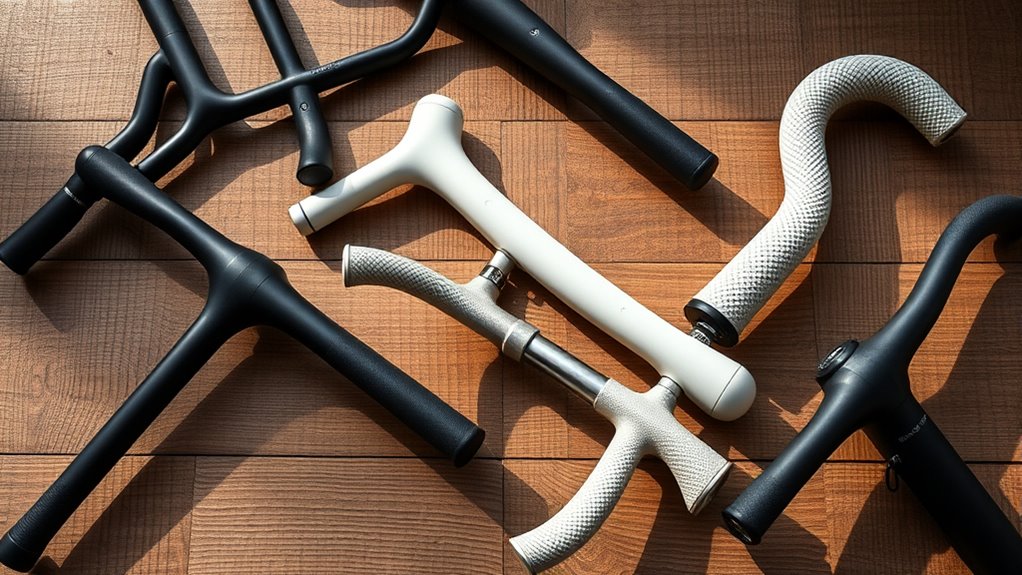
Riser bars give you a more comfortable riding position, helping reduce fatigue on long off-road rides. They also improve handling control, making it easier to navigate tricky trails. With these benefits, riser bars are a popular choice for riders seeking both comfort and confidence. Proper installation and maintenance ensure your riser bars stay safe and effective during rides. Additionally, understanding regional trail conditions can help you select the best bars for your specific terrain and riding style. Developing a mood board can also assist in visualizing your ideal riding setup and style preferences for your bike components. Incorporating antique-inspired elements into your bike accessories or gear can add a unique, personalized touch to your riding environment.
Enhanced Riding Comfort
If you’re looking for increased comfort and better control during off-road rides, riser bars are an excellent choice. They elevate your hands, reducing strain on your wrists and shoulders, making long rides more comfortable. Incorporating high-quality home decor elements into your bike setup, such as stylish handlebar accessories, can also enhance your riding experience. To maximize comfort, consider adding ergonomic grips, which provide better support and reduce fatigue. Handlebar accessories like padded tape or vibration-dampening inserts can also help absorb shocks from rough terrain. Riser bars encourage a more upright riding position, relieving pressure on your back and neck. This setup not only enhances comfort but also boosts confidence when tackling challenging trails. Understanding spiritual energy and aligning your mental state can further improve your focus and enjoyment during rides. With the right combination of ergonomic grips and handlebar accessories, you’ll enjoy a smoother, less tiring off-road experience that keeps you riding longer and more comfortably.
Improved Handling Control
By providing a higher and more stable hand position, riser bars considerably enhance your control on rough terrain. This improved handling is essential for navigating technical trails and maintaining balance. To maximize comfort and grip, consider ergonomic grips that reduce fatigue, especially over long rides. Handlebar accessories like additional padding or bar ends can further boost stability and control. Here’s how different aspects contribute:
| Feature | Benefit | Example |
|---|---|---|
| Riser Height | Increased leverage and stability | Higher rises for rough terrain |
| Ergonomic grips | Reduced hand fatigue | Gel or foam grips |
| Handlebar accessories | Customization for comfort | Bar ends, padding |
| Control Enhancers | Precise handling | Adjustable stems |
Incorporating proper sizing ensures optimal fit and performance, helping you stay confident and in control, no matter the trail conditions. Additionally, understanding handlebar design principles can further improve your riding experience by tailoring your setup to specific riding styles and terrains. Moreover, staying informed about sound design techniques can inspire creative ways to customize your riding experience through audio cues and feedback.
Bullhorn Bars: Combining Reach and Leverage
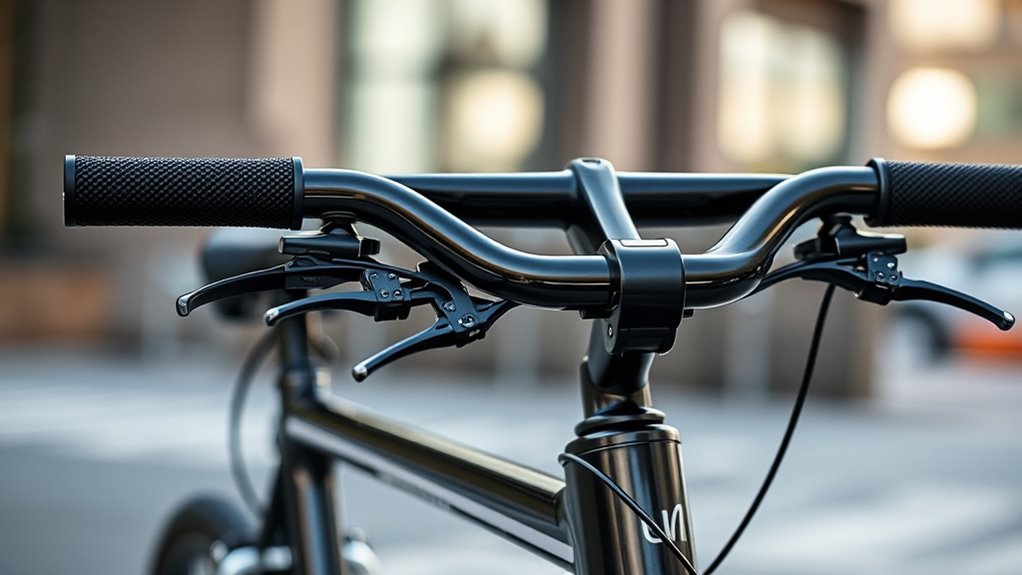
Bullhorn bars are designed to offer a unique combination of reach and leverage, making them a popular choice for riders seeking both control and comfort. Their shape allows you to extend your reach comfortably while providing excellent leverage for quick acceleration or maneuvering. You can customize your handlebar grip to suit your riding style, whether you prefer cushioned grips for long rides or ergonomic options for added comfort. Handlebar accessories, such as bar tape or handlebar tape, can enhance your grip and reduce fatigue. The open, forward-facing design also makes it easy to switch hand positions, giving you flexibility during rides. Proper handlebar setup can further optimize your control and comfort during your rides. Additionally, selecting the right handlebar type can influence your riding experience, especially considering different family backgrounds and personal preferences. Incorporating ergonomic considerations into your handlebar choice can improve overall riding comfort and reduce strain. For example, understanding how IRA withdrawals impact your financial planning can help you make more informed decisions about your cycling investments and expenses. A well-chosen handlebar can also accommodate various unique and wicked planters or accessories to enhance your cycling experience. Overall, bullhorn bars blend the benefits of reach and leverage, making them ideal for urban commuting, fitness riding, or spirited rides on varied terrain.
Aero Bars for Speed and Efficiency
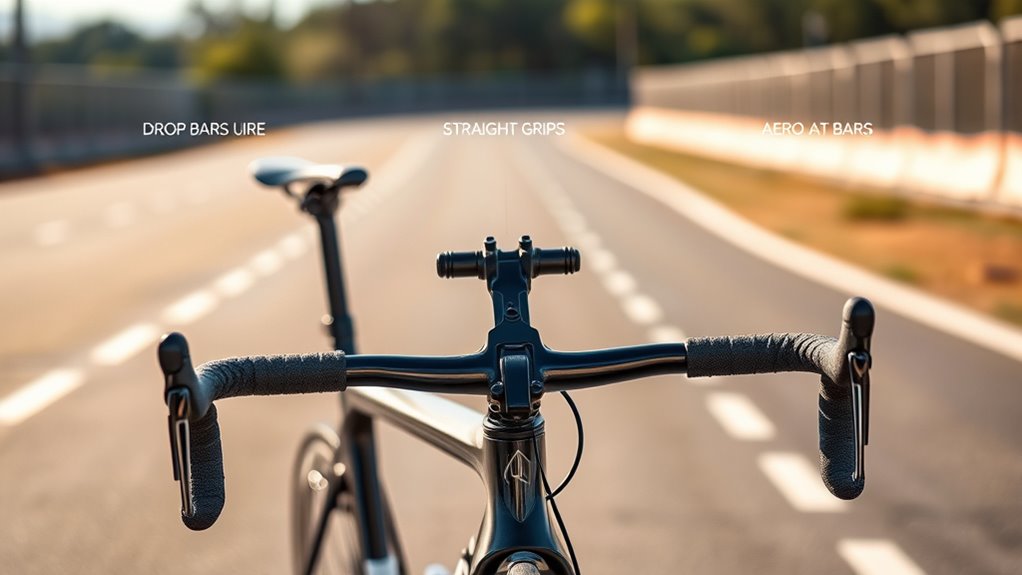
Aero bars are designed to help you cut through the air more efficiently, making them ideal for riders aiming to maximize speed and reduce fatigue on long rides. They position your hands forward, streamlining your body and minimizing drag.
When choosing aero bars, consider handlebar width to guarantee a comfortable fit that suits your torso and riding style. Grip ergonomics are also essential; look for padded, contoured grips that support your wrists and reduce strain during extended use.
Visualize yourself gliding smoothly with:
- A narrow, aerodynamic profile for reduced wind resistance
- Adjustable arm rests for personalized comfort
- Tapered extensions that allow a natural, relaxed grip
These features work together to enhance your efficiency, helping you stay in a more aerodynamic posture longer. Proper handlebar width and fit are crucial for achieving optimal comfort and performance during your ride. Additionally, selecting components like handlebar materials can impact overall weight and durability, further optimizing your cycling experience. For added performance, considering aero bar customization options can help tailor the setup to your specific needs and riding style.
Incorporating adjustable components can also help you fine-tune your position to optimize cycling aerodynamics, leading to better overall performance. Being aware of your body positioning can significantly improve your comfort and efficiency during long-distance rides.
Compact and Street Bars for Urban Cycling
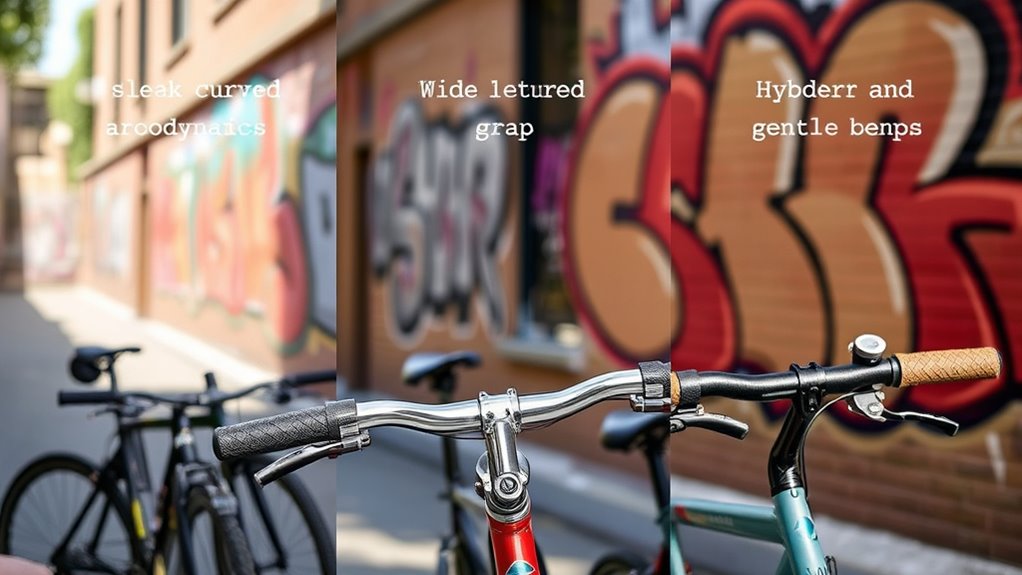
For urban cycling, compact and street bars offer a practical balance of control and comfort in tight, stop-and-go environments. Their shorter reach and sweep make handling easy during city navigation. You can choose handlebar grip styles that enhance comfort and control, such as ergonomic or padded grips, to reduce fatigue during long rides. When selecting handlebar sizing guidelines, measure your stem length and handlebar width to ensure a proper fit—this prevents strain and improves handling. Compact bars often feature a flatter top section, providing multiple hand positions for varied riding. Additionally, understanding the different handlebar types can help you choose the best option for your urban cycling needs. Knowing how handlebar design impacts your riding posture can further enhance comfort and control during your commute. Incorporating home decor elements like wall organization or aesthetic accessories can also create a more enjoyable and personalized riding space or storage area.
Choosing the Right Handlebar Based on Riding Style

Choosing the right handlebar depends heavily on your riding style, as different handlebars optimize performance and comfort for specific activities.
For example, if you prioritize agility, a lightweight handlebar with minimal handlebar weight helps improve handling. If comfort is your goal, look for handlebars that suit your riding posture and are compatible with your bike’s setup.
Consider these options:
- Flat bars for city commuting and casual riding
- Drop bars for long-distance and racing, offering multiple hand positions
- Wide handlebars for mountain biking, providing better control
Ensuring handlebar compatibility with your bike’s stem and accessories is vital. The handlebar weight can influence your ride’s ease, especially over long distances. Selecting the appropriate handlebar style also involves understanding how different types support various riding goals and riding postures, ensuring a comfortable and efficient ride.
Choose a style that matches your riding goals and fits seamlessly with your bike.
Material Options and Their Impact on Handlebar Performance
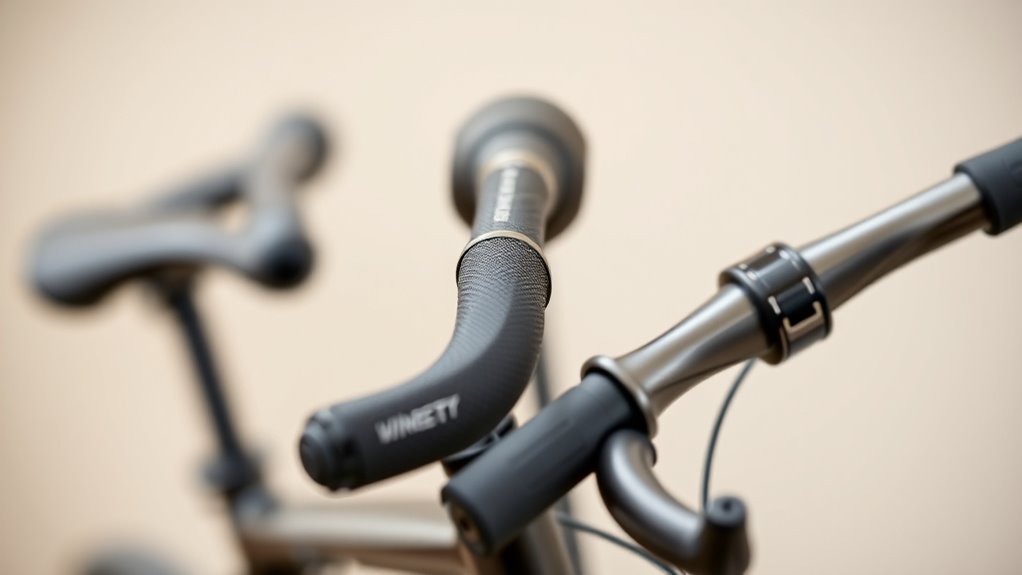
The material of your handlebar considerably influences its strength, weight, and overall riding experience. Handlebar materials vary, including aluminum, carbon fiber, and steel, each offering distinct benefits.
Aluminum handlebars are popular for their lightweight nature and good material durability, balancing strength with affordability.
Carbon fiber handlebars excel in reducing weight and absorbing road vibrations, but they may be more prone to damage if not handled carefully.
Steel handlebars are known for their exceptional durability and toughness, making them ideal for rough terrain or heavy-duty use, though they tend to be heavier.
Your choice of handlebar material impacts performance, especially in terms of weight savings, vibration absorption, and durability under stress. Selecting the right material ensures your handlebar meets your riding needs while maintaining longevity.
Ergonomic Designs and Adjustable Features
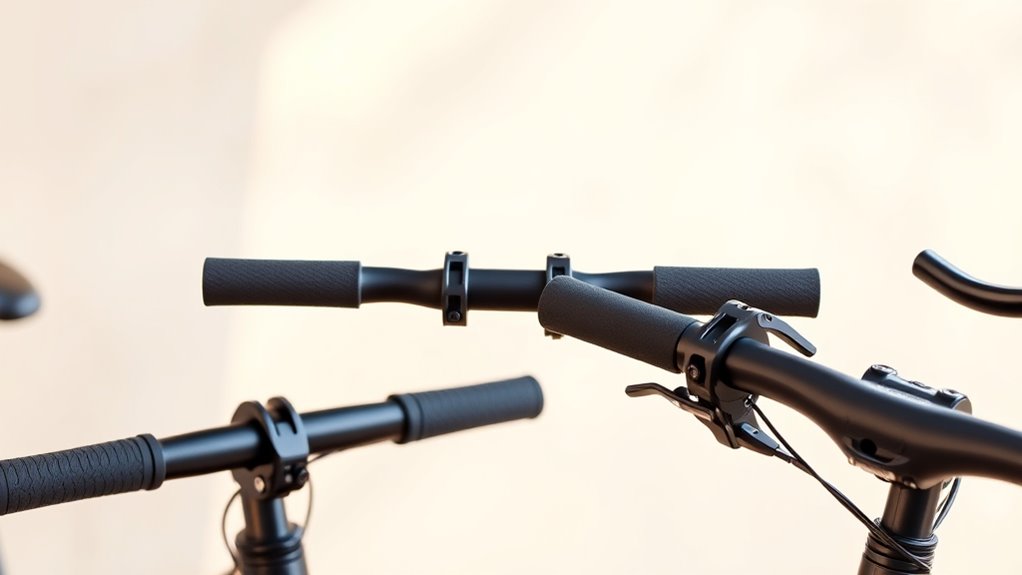
Ergonomic designs and adjustable features enhance comfort and control, allowing you to customize your riding position to suit your preferences. With adjustable grips, you can fine-tune the grip height and angle for better hand comfort and reduced fatigue.
Ergonomic bends in handlebars promote a natural wrist position, decreasing strain during long rides. These features help you find the perfect fit, improving overall riding efficiency.
Picture handlebars with:
- Adjustable grips that lock into different positions
- Ergonomic bends that match your wrist’s natural curve
- Customizable height and angle options for tailored comfort
This combination ensures you can adapt your handlebar setup for ideal ergonomics. Whether you’re cruising or racing, these features help you stay comfortable and in control, ultimately enhancing your ride experience.
Tips for Installing and Maintaining Your Handlebar
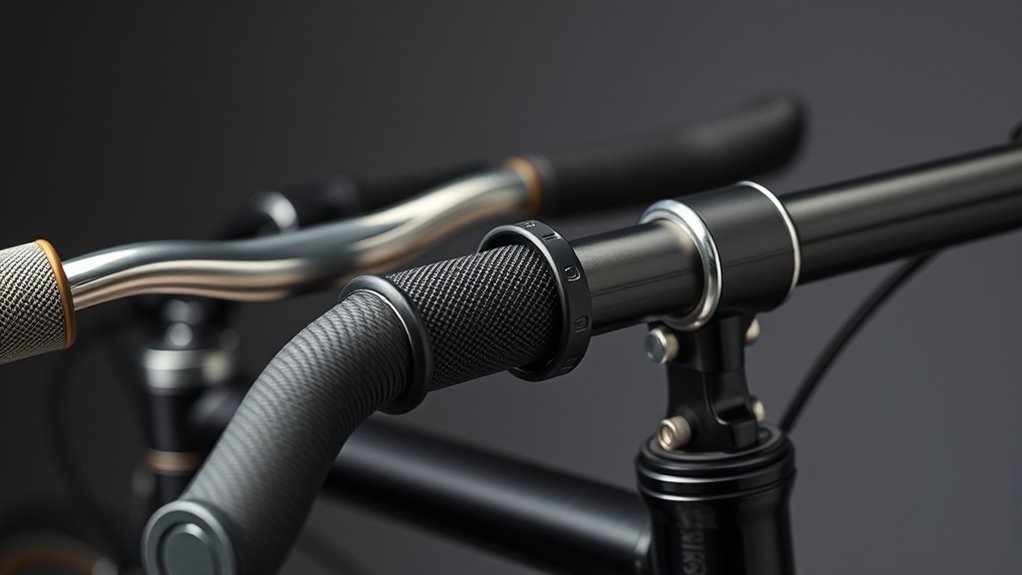
Installing your handlebar correctly guarantees safety and comfort. So follow manufacturer instructions and double-check tightness.
Regular maintenance, like cleaning and inspecting for wear, keeps your handlebar in top shape.
Staying proactive with these practices helps prevent issues and extends the lifespan of your handlebars.
Proper Installation Techniques
When installing your handlebar, paying attention to proper techniques guarantees safety and peak performance. First, confirm handlebar measurements match your bike’s stem and your body size for ideal grip comfort. This prevents discomfort and improves control.
Next, tighten all bolts gradually in a cross pattern to evenly distribute pressure and avoid damage. Check that the handlebar is aligned correctly with the front wheel for proper steering.
- Verify your handlebar width and rise suit your riding style
- Adjust the angle to ensure comfortable hand positioning
- Use a torque wrench to achieve the recommended tightening specs
These steps help maintain handlebar stability and comfort, making your ride safer and more enjoyable. Proper installation is key to maximizing your handlebar’s performance.
Routine Maintenance Practices
Regularly inspecting and maintaining your handlebar guarantees it stays secure, comfortable, and safe to ride. Start by checking handlebar sizing to confirm it fits your riding style and body dimensions. Proper sizing prevents strain and improves control.
Tighten any loose bolts, especially where the handlebar connects to the stem, and verify that the handlebar is centered correctly.
Pay attention to grip ergonomics; replace worn or uncomfortable grips to maintain control and reduce fatigue.
Adjust handlebar height and angle as needed for comfort and ideal riding position.
Regular maintenance also involves cleaning the handlebar and grips to prevent dirt buildup.
Frequently Asked Questions
Which Handlebar Type Is Best for Long-Distance Touring?
For long-distance touring, you want a handlebar that offers comfort and versatility. You should choose one with ergonomic grips to reduce fatigue and handlebar accessories like additional padding or mounts for gadgets.
This allows you to switch positions easily, preventing numbness and discomfort. A handlebar designed for comfort helps you stay relaxed on extended rides, making your journey more enjoyable and less tiring.
How Do Handlebar Widths Affect Riding Comfort?
Handlebar width directly impacts your riding comfort. A wider handlebar provides an ergonomic grip, offering better control and reducing hand fatigue on long rides.
Conversely, narrower bars can feel less stable but improve aerodynamics. Choosing the right width depends on your body size and riding style, ensuring you maintain a natural hand position.
Properly fitted handlebars help you stay comfortable and prevent strain during extended cycling sessions.
Can I Switch Handlebar Types on My Existing Bike?
Ever wondered if you can switch handlebar types on your bike? Yes, you can, but handlebar compatibility and bike frame modifications matter.
You’ll need to verify if your bike’s stem and fork can fit the new handlebars, especially if switching from drop to flat bars or vice versa. Sometimes, you might need new components or adjustments.
Always consult a bike shop to ensure safe, proper fitting before making changes.
What Safety Considerations Are There When Choosing Handlebars?
When choosing handlebars, safety is key. You should consider ergonomic design to guarantee comfort and reduce fatigue, especially on long rides.
Material durability matters too—sturdy materials like aluminum or carbon fiber can withstand stress and prevent accidents.
Make sure the handlebars fit your riding style, providing good grip and control.
Proper installation and regular checks are essential for safety, regardless of the handlebar type you select.
Are There Handlebar Options Suitable for Children or Beginners?
When choosing handlebars for children or beginners, you want to prioritize safety and comfort. Look for options with ergonomic grips to reduce hand fatigue and improve control.
Children’s handlebars are designed smaller and with gentle angles to suit little riders, making them easier to handle.
Flat handlebars are often ideal for beginners, providing stability and confidence.
Always guarantee the handlebars are properly fitted and securely attached to keep your ride safe and enjoyable.
Conclusion
Choosing the right handlebar is like finding the perfect pair of shoes—it makes every ride more comfortable and enjoyable. Whether you prefer the sleek speed of drop bars or the relaxed control of flat and riser options, understanding their features helps you ride confidently. Take your time to select the best fit for your style, and don’t forget to maintain it like a trusted tool. With the right handlebar, every journey feels smoother and more fun.
